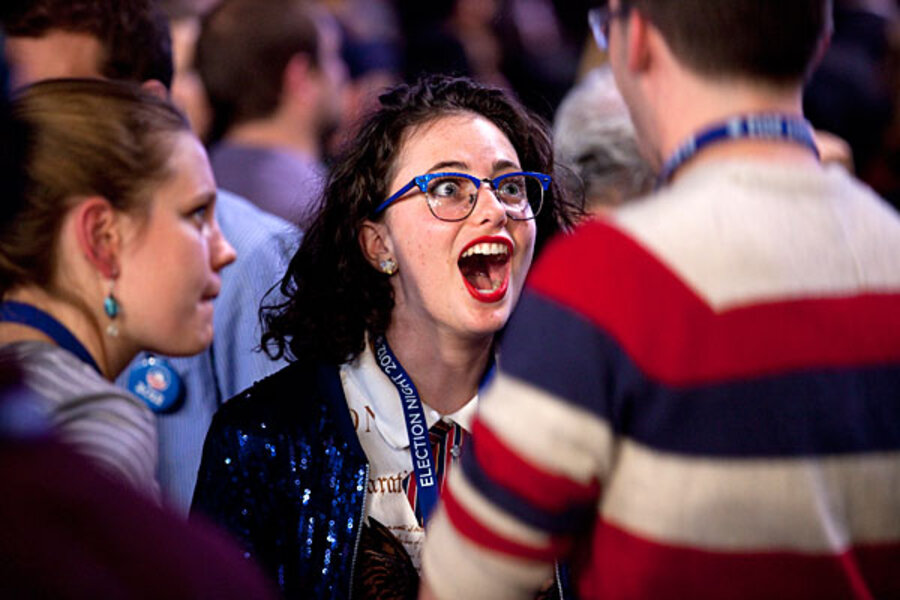Youth vote decides presidential election – again. Is this the new normal?
Loading...
Millennials made it to the polls in droves Tuesday – proving themselves a central voting bloc in swing states and defying speculation that their enthusiasm had waned since the days of Barack Obama’s historic candidacy in 2008.
People age 18 to 29 made up 19 percent of voters in this election cycle, up 1 percentage point from 2008, according to early National Exit Poll (NEP) data.
President Obama won this age group with 60 percent support, versus 37 percent for Mitt Romney.
If Mr. Romney had received at least 50 percent of the support of this age group in the swing states of Ohio, Virginia, Pennsylvania, and Florida, 80 electoral votes would have gone his way, winning him the presidency, according to an analysis by CIRCLE, an independent research center that measures youth engagement in politics.
Of all people under 30 who were eligible to vote, at least 49.3 percent did register and cast a ballot, a number that could rise to 51 percent in the final analysis and basically match the youth turnout of 52 percent in 2008, CIRCLE reports, based on its analysis of NEP data. That’s between 22 and 23 million people.
The youth turnout is about 10 points lower than estimates of the turnout rate overall, as in past elections. But it’s up significantly from 1996, when just 37 percent of the under-30 set voted.
“It’s a new normal, with about half of the millennial generation voting … and they make a decisive difference,” said CIRCLE director Peter Levine in a press call Wednesday.
Voter advocacy groups ranging from the League of Women Voters to Rock the Vote spent weeks leading up to the election challenging new voter laws that would hinder young voters and ensuring that young people had the information they needed to understand ID requirements and options for casting their votes. Students mounted registration drives and made sure people who wanted to vote early could get rides.
“Young people are savvy, and they’re committed to this idea is that their participation is how they take back power in this country,” says Heather Smith, president of Rock the Vote, a nonpartisan youth-engagement organization. And if the voting systems were less antiquated and easier to navigate, the youth turnout would probably have been even higher, she says.
As it was for other Americans, the economy was the top issue for young people heading into the election, surveys have shown.
Unemployment for 18- to 29-year-olds is 12 percent, compared with under 8 percent for the nation as a whole, according to Generation Opportunity, a nonpartisan group launched in 2011 to engage young people on economic issues through social media.
While the bulk of young people voted to give the president four more years to try to make a dent in that issue, his support among them did drop 6 percentage points compared with 2008.
Only 38 percent of young people believe that today’s political leaders reflect the interests of young Americans, according to Generation Opportunity polls.
That’s significant, because by 2020, millennials will make up 38 percent of the electorate, and both parties need to “focus on solutions that matter: job creation and dealing with the debt,” says Paul Conway, president of Generation Opportunity and a former Labor Department chief of staff.
Obama and his campaign reached out to young people and through social media, where they engage with issues that matter to them 24/7, says Mr. Conway. The Republican Party needs to realize that reaching out to this demographic is worthwhile for them too, and it will take more than some slick YouTube videos, he says. “To think they are all liberal just because 60 percent supported the president is illogical,” he says.
In California, online registration and ballot initiatives of interest to young people may help explain why young people, who make up just under 24 percent of the population, were actually 28 percent of the voters, CIRCLE's Mr. Levine said.
The overwhelming support for Obama among African-American and Latino voters also overlaps with the youth vote. Among under-30 voters in those groups, 91 percent and 72 percent, respectively, voted for Obama, according to CIRCLE.







